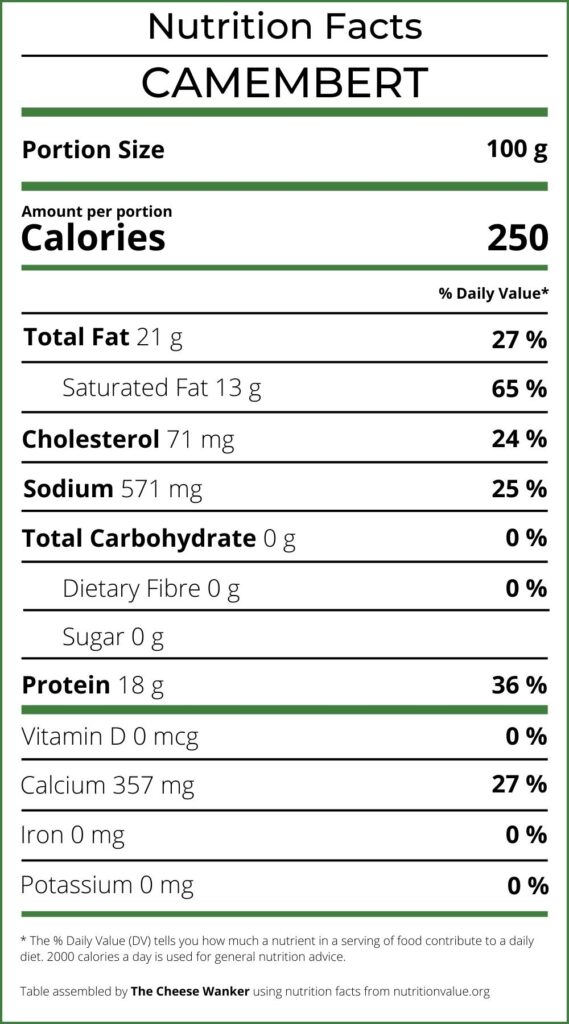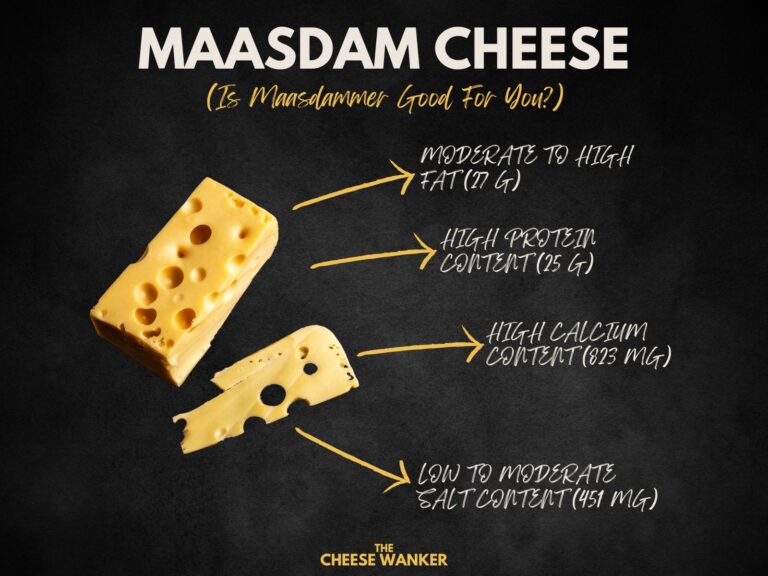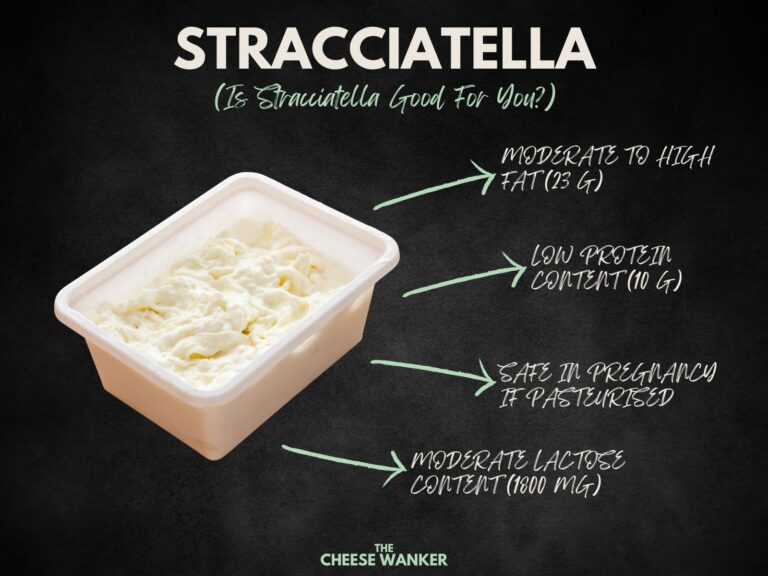With its creamy texture and unique complex flavour, Camembert has become a beloved choice for cheese enthusiasts around the world. However, to fully appreciate this indulgent treat, it is essential to understand its nutritional composition. In this blog post, we will delve into the nutrition facts of Camembert. Read on to learn about its lactose content, protein profile, safety in pregnancy and more.
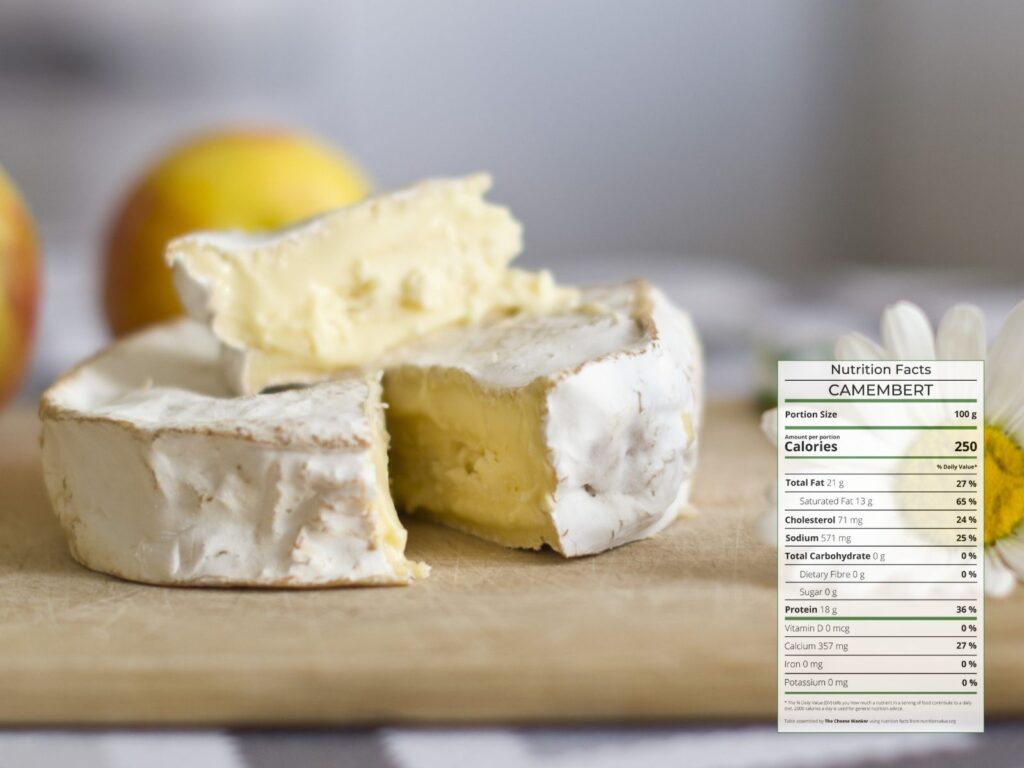
SEE ALSO: Nutrition facts for popular world cheeses in The Cheese Wanker’s index →
What is Camembert?
Camembert is a soft white mould cheese made from cow’s milk. Originating from Normandy, France, this cheese undergoes a meticulous artisanal production and maturation process. As a result, Camembert develops a characteristic soft, creamy texture and an earthy, nutty flavour profile.
While the original Camembert de Normandie is made with raw milk, there are a number of versions made in France and around the world using pasteurised milk.
Nutrition fact sheet
Country of origin
France
Type of Cheese
Milk
Cow (Raw or Pasteurised)
Examples
Camembert de Normandie, Le Conquérant Camembert, Petit Camembert, Camembert au Calvados
Safe
Avoid
Milk Protein Intolerance, Pregnancy*, Lactose Intolerance, Low Sodium Diet
Nutritional review for Camembert
Eating healthy plays a pivotal role in maintaining overall well-being and preventing chronic diseases. A balanced and nutritious diet provides our bodies with essential vitamins, minerals, and macronutrients, fuelling optimal physical and cognitive function.
With this in mind, let’s have a look at some of the key nutrition facts for Camembert.
Lactose Intolerance
For people with lactose intolerance, the consumption of dairy products can be problematic. Fortunately, Camembert is relatively low in lactose due to the fermentation process, during which bacteria break down lactose into simpler components.
As a result, many lactose-intolerant individuals can enjoy moderate portions of Camembert without experiencing discomfort.
However, lactose sensitivity can vary from one person to the next. Hence, we recommend a degree of caution if you’re trying this cheese for the first time. As always, our advice is to try a small portion, on a day that you will spend indoors.
Fat Content
Camembert, like most cheeses, contains a substantial amount of fat. Approximately 20% of its weight is fat, making it a calorie-dense option. However, the richness of the fat contributes to its luxurious mouthfeel and distinctive taste, making it a cherished delicacy.
While high in fat, it’s essential to remember that not all fats are detrimental. Camembert contains a good balance of saturated and unsaturated fats, including beneficial omega-3 fatty acids.
You can learn more about the different types of fat in cheese and which cheeses have the lowest fat content here.
Cholesterol Content
As is often the case with cheese, Camembert contains a moderate amount of cholesterol. However, research indicates that the cholesterol in cheese may not significantly impact blood cholesterol levels in most people.
Hence, moderate consumption of Camembert, as part of a balanced diet, is unlikely to pose a health concern for individuals with normal cholesterol levels.
Protein Content
As a dairy product, Camembert provides a significant source of protein. Protein is crucial for tissue repair, enzyme production, and immune function. A 100g serving of Camembert typically contains about 18-20 grams of protein.
Want to find out which cheeses have the highest protein content? Click here for our blog post covering cheeses with the highest protein content.
Safety in Pregnancy
Unfortunately, food safety authorities in Australia, the United Kingdom and the United States of American all agree that you should avoid soft white mould cheeses like Camembert during pregnancy.
The reason for that is that they have a high moisture content and low acidity. That combination provides the perfect environment for Listeria to proliferate.
Of course, if you’re unsure of what you can eat during pregnancy, you should consult your healthcare professional to get a personalised plan. You can read more about which cheeses you can eat when you’re pregnant by clicking here.
Salt Content
Like other cheeses, Camembert contains salt as a natural preservative and flavour enhancer. High salt intake can contribute to hypertension, so it’s best to consume Camembert in moderation as part of a balanced diet.
You can read more about why salt is important in cheesemaking in our comprehensive post here.
Calcium Content
Calcium is an essential mineral for bone health and various physiological processes. Camembert is a moderate source of calcium, offering approximately 350 mg of calcium per 100g serving, making it a delightful way to boost your calcium intake.
Conclusion
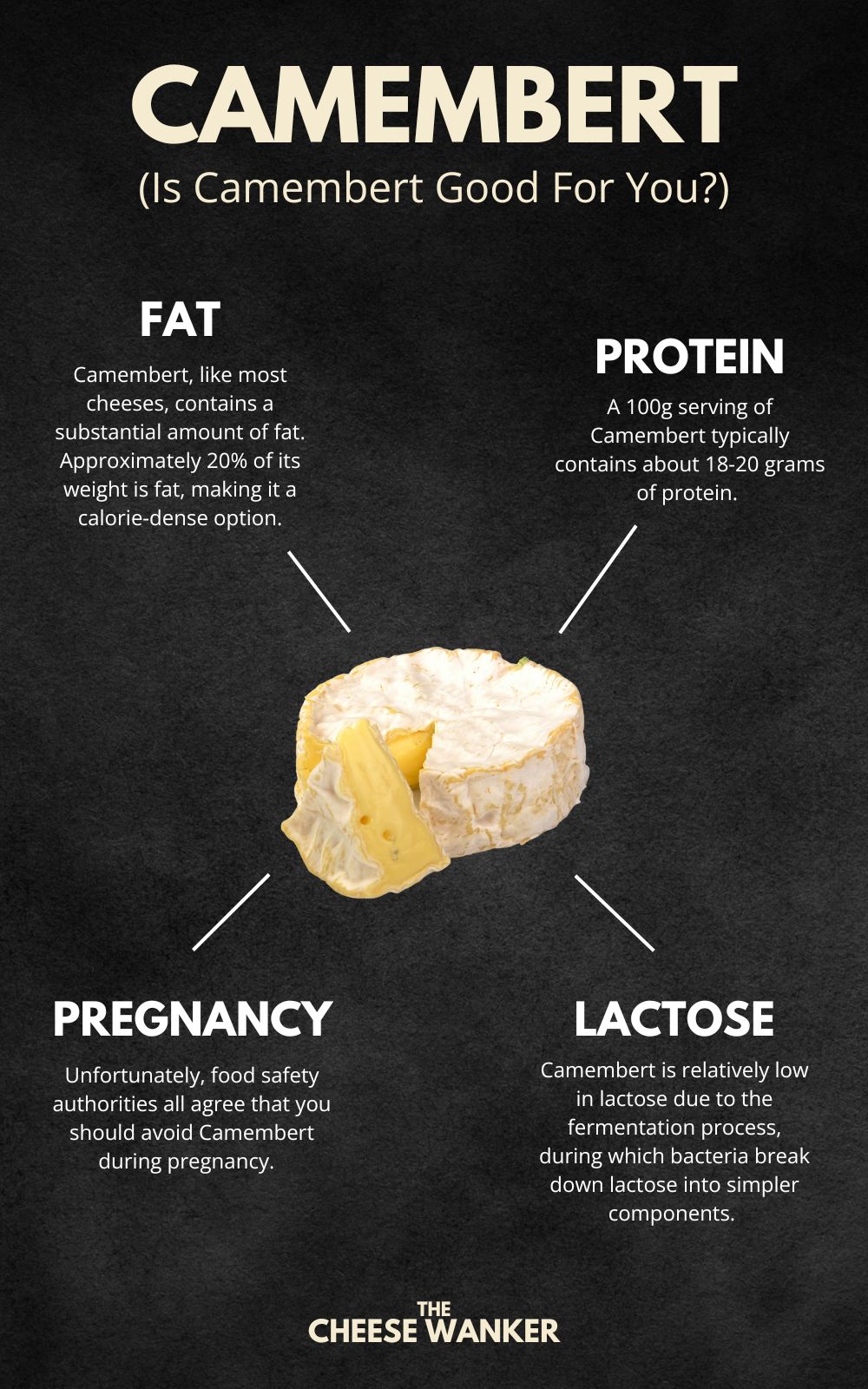
In conclusion, Camembert stands out as a delectable and versatile dairy product that has earned a special place in culinary traditions worldwide. Despite its high-fat content and cholesterol levels, its nutritional profile offers valuable protein and calcium to the diet.
For those with lactose intolerance, it can be a more tolerable cheese option. However, during pregnancy, caution is advised due to the risk of listeriosis. By understanding the nutrition facts of Camembert, cheese enthusiasts can make informed choices.
What’s your favourite Camembert pairing? Let us know in the comments below.
References
Overall nutritional content
The nutritional content of cheese in our table comes from the USDA Food Data Central Repository, the Australian Food Composition Database and cheese manufacturers. We realise that there can be variations between different brands and producers. Hence, the numbers we have used are averages.
Fat content
Our fat RDI data comes from Cleveland Clinic’s Healthy Fat Intake resource.
Type of fat in cheese as per Harvard T.H. Chan’s The Nutrition Source.
Protein content
Our protein RDI data comes from Harvard Medical School’s Harvard Health Publishing.
Cholesterol content
Is There a Correlation between Dietary and Blood Cholesterol? Evidence from Epidemiological Data and Clinical Interventions? – Maria Luz Fernandez and Ana Gabriela Murillo
Saturated fat, carbohydrate, and cardiovascular disease – Patty W Siri-Tarino, Qi Sun, Frank B Hu and Ronald M Krauss
Effect of cheese consumption on blood lipids: a systematic review and meta-analysis of randomized controlled trials – Janette de Goede, Johanna M Geleijnse, Eric L Ding, Sabita S Soedamah-Muthu
Safety in pregnancy
All the advice relating to what cheeses you can eat during pregnancy in this article is based on the recommendations by health authorities in Australia, the UK and the USA. If you are unsure about what you can or cannot eat, please consult your doctor.
Australia – FSANZ, United Kingdom – NHS and United Sates of America – FDA
Lactose content
Lactose residual content in PDO cheeses
Detection of lactose in products with low lactose content
The analysis of lactose in milk and cheese products by HPLC
Food Standards ANZ Food Composition Database
Lactose & Galactose content of cheese
